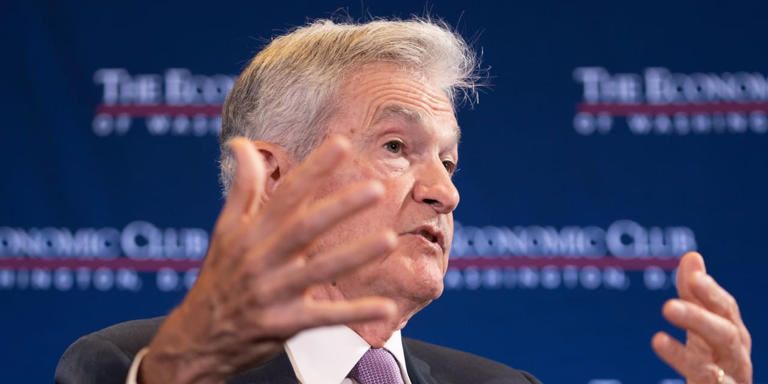As the U.S. grapples with easing inflationary pressures and diminished fears of an overheating economy, many economists and financial analysts are forecasting that the Federal Reserve will lower its benchmark interest rate in September. This anticipated move would mark the first reduction in rates for this cycle, but the exact trajectory of future rate adjustments remains highly debated and uncertain.
Current Federal Reserve Policy
For over a year, the Federal Reserve has kept its policy rate within the range of 5.25%-5.5%. This elevated rate has been maintained to slow down economic demand and address inflationary pressures, which have been a concern for policymakers. The current rate level is notably higher than the neutral rate, estimated at around 3%, which is considered neither stimulative nor restrictive to economic activity. The Fed’s prolonged period of high rates has been aimed at curbing inflation and stabilizing the economy.
Forecasts and Predictions
With inflation showing signs of softening, the focus has shifted to potential changes in monetary policy. Economists have diverged into two main camps regarding the future path of interest rates:
- Recalibration Approach:
- Some economists suggest a more dramatic initial cut in interest rates. They anticipate that the Fed might implement a substantial reduction of 75 to 100 basis points in September before potentially pausing to assess the impact of this change. This approach reflects a belief that a significant adjustment might be necessary to realign monetary policy with the current economic conditions.
- Gradual Reduction Approach:
- Another group of economists predicts a more gradual adjustment to monetary policy. This perspective suggests that the Fed will start with a smaller rate cut in September and then follow up with incremental reductions over time, bringing the benchmark rate closer to the neutral level of around 3%. This gradual approach reflects a cautious strategy, aiming to balance the need for economic support with the potential risks of rapid rate changes.
Market Expectations and Economic Indicators
Traders in derivative markets have largely aligned with the gradual reduction approach. They have priced in expectations for approximately 175 basis points of rate cuts, which would lower the benchmark rate to a range of 3.5%-3.75% by mid-2025. This projection implies a steady easing of monetary policy over the next year and a half, rather than a series of immediate, large cuts.
However, some analysts caution that market expectations might be overly optimistic. Michael Gapen from BofA Securities has highlighted a potential disconnect between market projections and realistic policy actions. He notes that earlier in the year, markets had anticipated numerous rate cuts that did not materialize, suggesting that current forecasts might be similarly optimistic.
Federal Reserve’s Likely Strategy
The Fed’s own projections, as indicated by the latest “dot-plot” forecasts, suggest a more measured approach. According to these projections, the Fed is expected to implement one rate cut in 2023, followed by four additional cuts in 2024, essentially averaging one cut per quarter. This gradual pace aligns with a cautious stance, aiming to ensure that each rate adjustment is appropriate given evolving economic conditions.
Stephen Brown from Capital Economics anticipates that the Fed will cut rates in September, potentially skip the November meeting, and then resume a steady pace of reductions in December. His forecast suggests that the benchmark rate could reach 3.5%-3.75% by mid-2025. Brown’s analysis emphasizes a return to a more typical economic environment, where less restrictive policy is appropriate without the need for aggressive rate cuts.
Matthew Luzzetti from Deutsche Bank shares a similar outlook, predicting a 25 basis point cut in September followed by additional reductions in November and December. Luzzetti believes that the Fed might then pause rate adjustments until September 2025. This approach mirrors the Fed’s “mid-cycle adjustments” seen in previous periods, such as the early 1990s and 2019, when the central bank made rate cuts without grappling with a recession.
Influence of Fiscal Policies and Future Uncertainties
It is crucial to recognize that future fiscal policies, particularly those of the incoming president, could significantly impact the Fed’s decision-making process. Any substantial fiscal changes or stimulus measures could alter the economic landscape and influence the Fed’s approach to monetary policy.
Upcoming Federal Reserve Meeting
The Federal Reserve is scheduled to meet next week, and it is widely expected to hold rates steady during this meeting. Economists anticipate that this meeting will serve as a precursor to a potential rate cut in September. According to Oxford Economics, the Fed is likely to use the upcoming meeting to signal that the first rate cut is imminent, setting the stage for subsequent adjustments.
Conclusion
As the Federal Reserve prepares for a potential reduction in interest rates, the exact path of future rate adjustments remains a subject of considerable debate. While market expectations lean towards a gradual reduction in rates, the Fed’s cautious approach and the influence of future fiscal policies suggest that the trajectory of monetary policy will be closely monitored by investors and economists alike. The upcoming Federal Reserve meeting will be a critical moment for setting expectations and guiding the future direction of interest rate policy.
